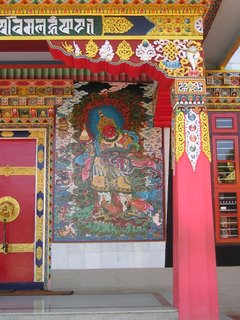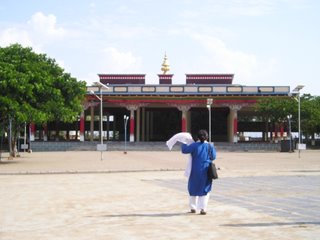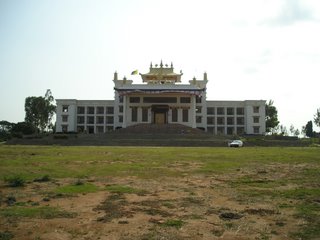

On the way to Coorg
We checked out of the accommodation after a sumptuous breakfast. The stop over at Srirangapattana to visit the temple turned out to be a little bit of a wrong move, because Hemant decided that we were very religious and he offered to stop by every random temple on the way. It was not right for me to suddenly drop a surprise on him indicating that none of us was a great believer and we could do without visiting several temples en route.
We decided that it would be a good idea to visit the Kabini Dam, now that we had seen the other side of it – the backwaters and the jungle it had devoured. I was somehow under the impression that this dam was of recent vintage but realized that the entire process of construction of the dam had started way back in 1968. We went all the way up to the gate and sought permission to walk on the dam. Vehicles were not allowed on the bund and at peak afternoon all of us started taking a walk. My idea was to get Arjun to get to the top of the main part of the  dam and also show the sluice gates. However it was indeed a long trek and with the weather being unfriendly we were not enthusiastic of a very long walk. So we went as far as we were cheerful, looking at both the waters and the construction. As we went nearer the main portion of the dam we suddenly saw some people [who were also at JLR Kabini] come in. All that they had done was to drive on the smaller path on the side of the bund and take steps up to the beginning of the dam. There was a fence that prevented people from coming in from the road to take these steps, but this was breached. Apparently their driver knew this and Hemant did not. We felt a bit foolish, but now had no choice. I for a moment thought that I should call Hemant on his mobile and ask him to come down, but decided against it.
dam and also show the sluice gates. However it was indeed a long trek and with the weather being unfriendly we were not enthusiastic of a very long walk. So we went as far as we were cheerful, looking at both the waters and the construction. As we went nearer the main portion of the dam we suddenly saw some people [who were also at JLR Kabini] come in. All that they had done was to drive on the smaller path on the side of the bund and take steps up to the beginning of the dam. There was a fence that prevented people from coming in from the road to take these steps, but this was breached. Apparently their driver knew this and Hemant did not. We felt a bit foolish, but now had no choice. I for a moment thought that I should call Hemant on his mobile and ask him to come down, but decided against it.
When we were going out, I received a call from Vishal. Right from the beginning I had this feeling that two nights at Coorg might be too hurried and had asked her to check with the hotel and extend our stay by a day. She had called to confirm that it was done, but however she could not get a good tariff for the last day. We thought we should attend to it later but should move on. So we were back in the car, on our way to Coorg. The road from Hand Post to Hunsur was not very good, but it was not as terrible as the last stretch that took us to Kabini. At Hunsur Hemant asked us if we wanted to break for lunch. Having had masala dosas in multiple numbers, none of us were in a mood for more food. We said that he could have his food, but he chose to drive on. Hemant was looking fresh after his full two day rest – I guess somewhat of a bonanza in this season. He also sounded happy.
He apparently was playing hockey and had played for Karnataka representing the rural team, till an injury did him in. He said that he had trained under Robin Utthappa’s father and knew most of the Hockey players well. A sad state for somebody who possibly was good but got left by the wayside as far as sport was concerned. As he knew this region well, we depended on him to guide us through the rest of the itinerary. He suggested that we could see Bayalukuppe, Nisargadhama and Dubbare elephant camp that day. The lady at JLR office in
My first brush with Bayalakuppe was of all the places in the 
A few months later, I was, going to have a look at the settlements. Gowri was all enthusiastic about this part of the trip as she was keen to buy a lot of Tibetan handicraft and trinkets. I was surprised to know that while we Indians could go to this area others needed special permission to visit the settlements. There are several settlements in this area and each one of them is a small kingdom in itself. Our first target was to go to settlement No. 4 – this seemed to have the best monastry [visually] with a golden temple. So we parked ourselves near the Namdroling Monastry. On the way we saw another impressive building, but decided to give it a skip as it did not seem to be open yet. Namdroling Monstry has a great temple – The Padmasambhava Temple with giant Buddha idols. It was a wrong day to visit the temple as a tourist. One of the Lamas had come in and there was much celebration and sermons going on. The place was packed with people and we had to satisfy ourselves with a view from outside. A remarkable feature of these settlements is that they do not even have a small trace of being in Karnataka or
We took a walk around the Namdroling Monastry and came out to the shopping centre. People had suggested that we could have great Tibetan food in the settlements including momo, but we decided to give it a pass as none of us were feeling hungry. Gowri was very disappointed with the shopping that the centre had to offer. It was full of trinkets that we would anyway find outside, except for some exclusive items like the prayer bells. There was also a lot of Feng Shui stuff there.
Anyways, we asked Hemant to take us to the next destination in Bayalakuppe. He drove us to a Seraje University of Buddhist Studies – a few kilometers away.  This belongs to a different monastry and is in a different settlement. It had an impressive building which was being renovated and also a very nice huge building where religious discourses and arguments were expected to be held. It gave a oriental, royal feeling and almost took us back into history because the décor was aimed at having two wise men arguing about something very philosophical with the king and all the courtiers watching. But there were no people there.
This belongs to a different monastry and is in a different settlement. It had an impressive building which was being renovated and also a very nice huge building where religious discourses and arguments were expected to be held. It gave a oriental, royal feeling and almost took us back into history because the décor was aimed at having two wise men arguing about something very philosophical with the king and all the courtiers watching. But there were no people there.
From the 
The building we saw was Kagyu monastry – with its fresh building. Infact several of the details were still in plastic cover and the entire building was really new. We went near the main door, and with permission entered. Some prayers were going on, and monks from the age of 4 through 60 were reading/reciting/singing and playing instruments. We hung around there for a few minutes. Our presence did not make a difference to the proceedings there, except for the fact that the younger monks gave us some curious looks.
Having seen Bayalukuppe, it was time to move towards Coorg, in the hope that the protestors would have got tired and would leave the traffic. As we were moving, Hemant was talking about how the settlers live in their own world and have never integrated with the local people. There was resentment in the fact that they came in as refugees and now [according to him] hire at least a lakh of other people in their enterprises, and these locals who work with the refugees have actually learnt Tibetan rather than the other way around! The settlements, particularly the monastries looked very well endowed and the concern expressed by Hemant might not actually have been misplaced. However I was and am curious to understand how the Tibetan economy runs, and what drives their finances. One thing that was very clear – there were too many western union outlets which was a clear indication that a lot of remittances were coming in. However it might be interesting to find out how the diverse settlements not only at Bayalukuppe, but more at Talawadi and other parts of
As we reached Kushalnagar, we were stopped. We had an hour to go. We asked Hemant to take us near some place away from the action and protest and get us some tea. We drove back for a while and got some black tea in a restaurant as milk had been exhausted. After about half hour of waiting we were on our way to Coorg, but were already late to visit Nisargadhama or Dubbare. Well, that was just as well as we were getting tired.
The drive in the roads leading to Coorg was great and it was really a green holiday for all of us. We reached Coorg and the hotel later in the evening and it was time for us to check in, have a wash and call up parents. The signals were showing on the mobiles and we were slowly inching back into the hustle and bustle. We on the way were trying to figure out the programme for the next morning.





































































![Hyderabad: A Book [or two] and A Movie](https://blogger.googleusercontent.com/img/b/R29vZ2xl/AVvXsEjAmLvl2QbxUfgXz7zmpX8bbEXlCt6AkaenV_pM9yxdKEg4dFja9dFAcL040l_itCPD3fhOxRtVemx4FI8A0iOpP93Q2QGTIKrTu6LHlZ4znvSL6DVgf9_gZJjyTcIa6Y6kKFU9/s214/luther1.0.jpg)







![Two Lives [and this is not about Vikram Seth]](https://blogger.googleusercontent.com/img/b/R29vZ2xl/AVvXsEjyC1A9f3rufuLjzeVMA0crhn0qgiHBS1Zqt0ldHFt_WUOeymC3NpId-cTQmht91UoJzhPAZ78gRZyQe0N0dnnx_UY-0Rf-8FDFhycKolr1Aqao6gFhWGQx7mT0oAHCZ-K-4LPL/s214/mansur.jpg)





1 comment:
Neevu enaadaru urduvinalli baredubittare adara jothe samvaadisodu hege antha ee kannadigana chinthe.
P. S. "Leave your comment" badalu prakatisi annodu sahaja. Chodo aap ke tippani annodanna kannadakke tharjume maadidre swalpa karkashavaagiruththe.
Post a Comment